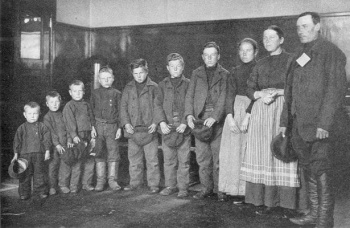From The Peopling of New York City
Contents |
Adaptations

Many German immigrants came alone to America in order to look for work. Being one of the earlier immigrants they had no family to receive them, but some may have deliberately broken off the ties to their families. Since family was not available many sought out friendships and people with common origins. Over time most found the companions unsuitable for long term replacements of family. The pseudo-family of the boarding house was rarely as reliable as those of family. Soon the immigrants demanded a reestablishment of family and kin because of the cultural expectations and long term satisfactions. In order to rebuild the environment most laborers encourage family members and kin to join them from the motherland. They would generally bring them over when they had the available currency for tickets. Some married in order to established new families in New York, even if they had family back in Germany.
Marriage for the Germans was a very complex aspect on its own. Germans would generally practice endogamy –marriage within a certain social or ethnic group- in New York. But, the marriages did not only account for ethnicity most had a strong tendency to have spouses that came from the same region of Germany. This regional endogamy could have arised from the need of linguistic compatibility since there were many German dialects.
Men generally looked for wives back in the homeland since they were “untainted” by the liberties given to women in New York City, but others did find spouses in local bars and salons.
Family Structure
There was a general pattern for the Germans in forming families. Families were generally nuclear families. Since the Germans desired the family setting many married at an early age, on average women had their first child at 23.9 and men were 28.1 at the birth of their first child. The average age of head of family was 35.5-37.5 from 1850-80. The average amount of children for each family was 2.66 in 1850 to 3.16 in 1880. It is probable that German American families practiced a form of family limitation since the average age of mothers when their last child was birth was low, on average the of 36 years. Coitus interruptus and abstinence were likely methods of birth control, and abortion was widely advertised within the German press.[2]
Economic Situations
Economic and occupation situations were factors in family formation for the Germans. In general the men were poorly skilled married later and had children later in comparison to those that were better equipped. Skilled workers and artisans began families at about the average age or younger, this included white collar workers. Property owner’s wives were generally the youngest after the birth of their last child, which is a probable because of the lower working hours. But, professionals married late because of the need to concentrate on their careers, but they had the average amount of children. These occupational and class differences in family development divided kleindeutschland like a quilt on top of the already quilt-like New York City.
References
- ↑ http://www.gutenberg.org/files/13181/13181-h/13181-h.htm
- ↑ Nadel, Stanley . Little Germany: ethnicity, religion, and class in New York City, 1845-80. Illinois: University of Illinois Press, 1990. Print.
- ↑ Nadel, Stanley . Little Germany: ethnicity, religion, and class in New York City, 1845-80. Illinois: University of Illinois Press, 1990. Print.
